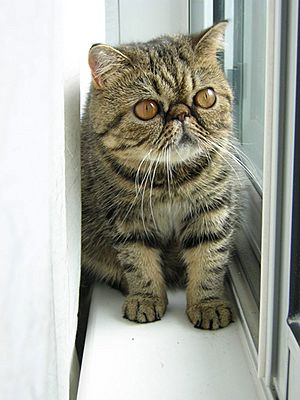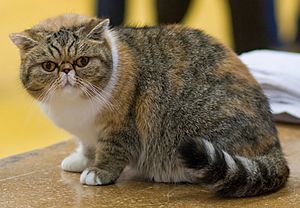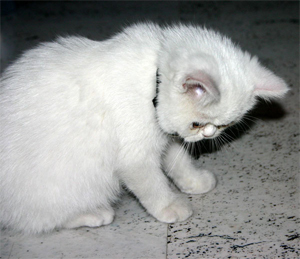Exotic Shorthair facts for kids
Quick facts for kids Exotic Shorthair |
|
|---|---|

Brown Tabby Exotic Shorthair
Male Cat – 9 year old |
|
| Origin | United States |
| Breed standards | |
| CFA | standard |
| FIFe | standard |
| TICA | standard |
| AACE | [facebook standard] |
| Domestic cat (Felis catus) | |
The Exotic Shorthair is a special kind of cat. It looks a lot like the famous Persian cat, but with short, thick fur instead of long hair. They have a cute, flat face and a calm personality.
Contents
How the Exotic Shorthair Breed Began
In the late 1950s, some breeders wanted to make American Shorthair cats look even better. They secretly mixed them with Persian cats. This mix made the American Shorthairs have a different body shape. Some breeders also used Russian Blue and Burmese cats in their breeding programs.
People started to notice these mixed-breed cats at shows. But some American Shorthair breeders were not happy. They created new rules to stop these mixed cats from being called American Shorthairs.
However, one American Shorthair breeder saw how special the Persian/American Shorthair mix was. In 1966, this breeder helped a judge named Jane Martinke recognize them as a new breed. They were given the name Exotic Shorthair.
By 1987, the Cat Fanciers' Association decided that only Persian cats could be mixed with Exotics. This helped keep the breed's look consistent.
Sometimes, Exotic Shorthairs can have a hidden gene for long hair. If two cats with this gene have kittens, some might be born with long hair. The Cat Fanciers' Association does not call these long-haired cats Persians. But another group, The International Cat Association, does accept them as Persians. Other groups, like the American Cat Fanciers Association, call them a separate breed: the Exotic Longhair.
What Does an Exotic Shorthair Look Like?
Exotic Shorthairs look very much like Persian cats. The only main difference is their short coat.
- Head: They have a large, round head. Their forehead is rounded, and their cheeks are full. They have a short, wide nose and a strong chin.
- Ears: Their ears are small and round at the tips. They are set far apart and have lots of hair inside.
- Eyes: Their eyes are big and round. They have a clear, deep color that matches their fur. Most have gold or copper eyes. Some have green or blue eyes.
- Neck: Their neck is short and thick.
- Body: They have a medium-sized, sturdy body. It is low to the ground with a broad chest and strong shoulders. They have strong bones and muscles. They usually weigh between 3.5 and 6 kilograms (about 8 to 13 pounds).
- Paws: Their legs are short and straight. Their paws are large and round, with tufts of hair between their toes.
- Tail: Their tail is short, thick, and carried low. It has a rounded tip.
- Coat: Their fur is short but a bit longer than other short-haired cats. It is dense, fluffy, and stands up from their body. They can have all the same colors as Persian cats.
Exotic Shorthair Personality
Exotic Shorthairs are known for being gentle and calm, just like Persians. But they are often a bit more playful and curious than their long-haired relatives. They get along well with other cats and dogs.
These cats do not like to be left alone. They love being with their owners and often show a lot of affection and loyalty. They enjoy sitting on laps and are very cuddly. Their calm nature makes them great pets for people living in apartments. However, Exotics still have some of the energy from their American Shorthair ancestors. They can be good mouse hunters!
Caring for an Exotic Shorthair
Exotic Shorthairs are much easier to groom than Persians. Their short fur stays tidy with little help. Still, it is a good idea to brush and comb them once a week. This helps remove loose hair and reduces shedding and hairballs.
Because of their flat faces, Exotic Shorthairs can have watery eyes. Their tear ducts might overflow, which can make their face damp and stained. You can help with this by gently wiping their face with a damp cloth. There are also special wipes made for this purpose.
This breed grows up slowly. They do not become fully mature until they are about two years old.
Exotic Shorthair Health
Exotic Shorthairs are a "brachycephalous" breed. This means they have a pushed-in face, with their nose and eyes close together. This can lead to some health issues. Besides watery eyes, they can also have sinus problems. Their shortened jaw might also cause their teeth to be misaligned or crowded.
Here are some health concerns for Exotic Shorthairs:
- Breathing Problems: Some Exotics can have a condition called Brachycephalic Airway Obstructive Syndrome. This causes problems with their upper airways, making it harder to breathe. It can range from mild to severe. To help, cats might need to lose weight, have surgery, or avoid hot and humid places.
- Bladder Stones: They can get stones in their bladder and kidneys. These are called Calcium oxalate urolithiasis.
- Kidney Disease: Exotic Shorthairs, like Persians, have a higher chance of inheriting Feline Polycystic Kidney Disease (PKD). This disease can lead to kidney failure. Many studies show that about 40-50% of Exotics in some countries have PKD. Breeders should test their cats for PKD using DNA screening. This helps reduce the number of cats born with the disease.
Recognition of the Breed
The Exotic Shorthair has become very popular among cat lovers. This is thanks to people who believed in the value of mixing Persians and Shorthairs.
- In 1967, the Cat Fanciers' Association first allowed the Exotic Shorthair to compete for Championship status.
- In 1971, the first Exotic Shorthair became a Grand Champion.
- In 1986, the Fédération Internationale Féline also recognized the Exotic Shorthair breed.
- In 1991, an Exotic Shorthair was named the Cat of the Year by the Cat Fanciers' Association.
- In 1992, an Exotic was chosen as the Cat Fanciers' Association's Best Kitten.
See also
 In Spanish: Gato exótico para niños
In Spanish: Gato exótico para niños




